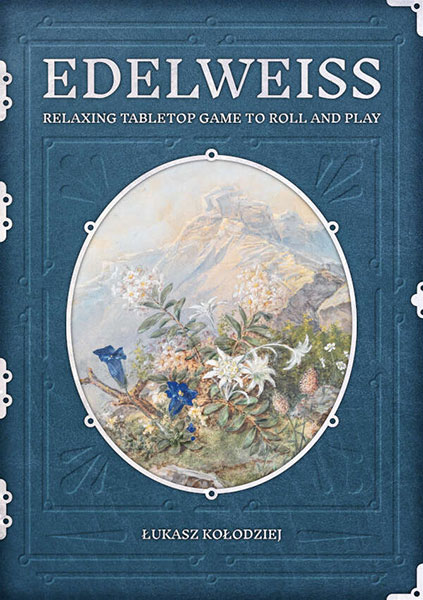Edelweiss by Łukasz Kołodziej is a free role playing game supplement published by Skavenloft. The supplement is covered by the Creative Commons Attribution 4.0 Unported license.
The supplement is available as a 30-page PDF for free from DriveThruRPG. Two pages are the front and rear covers, two the front matter and one the Table of Content. There is also a second, single page PDF that is a character sheet.
 The single page Introduction explains that this is a cosy game with no monsters, no risk and almost no dice, just a heartwarming story. It explains it can be played solo or with friends, and a session should take an hour or two. A story completed in one session is a one-shot, one that takes a few sessions is an adventure and one that takes more than ten is a campaign. At least one six-sided die is needed.
The single page Introduction explains that this is a cosy game with no monsters, no risk and almost no dice, just a heartwarming story. It explains it can be played solo or with friends, and a session should take an hour or two. A story completed in one session is a one-shot, one that takes a few sessions is an adventure and one that takes more than ten is a campaign. At least one six-sided die is needed.
Rules starts by explaining that you are creating a story by choosing a protagonist, what they are trying to achieve and how they do that. It explains the differences between solo and multi-player games, and that you may wish to record the story. Should some excitement be wanted, players can choose to roll a die at any time to see if an action succeeds or not; they can always choose instead. It explains about what’s included in the World section, expanding it and using the lists.
Characters are created by choosing one trait from each category. The categories are ancestry, being giant, gnome or human, lifepath, being craftsman, mystic, artist or scholar, gear, being thrift, extensive or random. Physical traits are hardy, strong, dextrous or fast, intellectual are intelligent, creative, resolute or wise and personality are beautiful, influential, composed or expressive. Age and gender are completely down to choice.
More details are things such as name and backstory, a party has a bond and a theme and there are perhaps relationships between characters. Traits can change and there are options for advancement for the ancestries, lifepaths and some general ones.
Story looks at the starting point, a long-term goal, with examples, and some short-term goals, also with examples. Examples are also given of obstacles and advantages, then how to pace the game, dialogue and finishing a story, as well as going back and making changes.
World has various lists for fleshing out the world, with different things covered, from landscapes to settlements to flora and fauna. There are details on spirits, the gods, the ancestries, lifepaths and organisations.
Examples has some examples of play.
The final page of content is a character sheet.
Edelweiss in Review
The PDF lacks bookmarks and has enough different sections that they would have been useful. The Table of Content covers the various sections and is hyperlinked. Navigation is okay. The text maintains a two-column format and appeared to be almost free of errors. There are a variety of public domain colour illustrations. Presentation is okay.
This game has more in common with journalling type games than other role playing games. The players have complete control over the story, and can choose whether or not anything is at risk. In fact, Edelweiss has even less randomness than a typical journalling game. It could perhaps be described as directed writing rather than a game, although what happens may or may not be written down. It’s certainly an easy game to learn. Edelweiss is not going to be to everyone’s taste and it can be downloaded for free by clicking here.

Leave a Reply